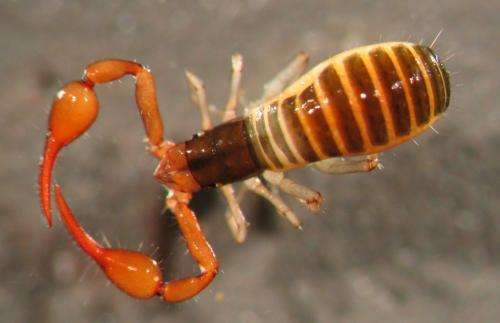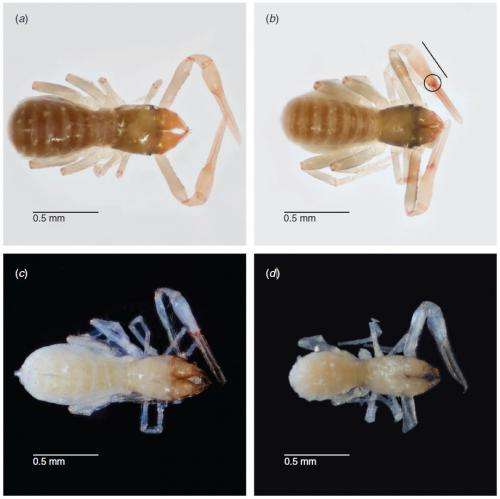Cave-dwelling pseudoscorpions evolve in isolation

Scientists studying pseudoscorpions living in aquifers in north-west Australia have found each aquifer is home to unique species that evolved in isolation, despite having a common ancestor.
University of Adelaide PhD candidate Sophie Harrison worked closely with WA Museum curator Dr Mark Harvey to analyse pseudoscorpions living in calcrete aquifers in the Yilgarn region, and in air-filled voids of fractured rock in the Pilbara region, Western Australia.
Ms Harrison extracted DNA from the legs of specimens from subterranean and above-ground pseudoscorpions of the genera Lagynochthonius and Tyrannochthonius, and amplified this DNA to isolate and sequence the CO1 and 18S genes.
She then compared these gene sequences to identify related specimens, discovering that species living in different aquifers evolved separately.
"Our results show that the pseudoscorpions studied invaded [aquifers and voids] in complete isolation from one another, and subsequently evolved in isolation too—like birds and bats both evolving wings," Ms Harrison says.
Previously, specimens were allocated to one of the two genera based on a single physical difference in pincer shape, but Ms Harrison's work indicates this is incorrect.
Evolving in the dark
Over time, as Australia became drier, surface invertebrates like pseudoscorpions that had previously thrived in rainforests invaded underground habitats such as caves, aquifers and fractured rocks.

Living in the dark, many of these troglofauna lost their sight, but adapted a heightened sense of hearing, touch and smell.
"Individual subterranean habitats formed island-like communities, each one with its own set of species, each with slight differences that have evolved as separate lineages as the animal adapted to suit its specific environment," Ms Harrison says.
"It's a bit odd that things could evolve multiple times, so we can't make any big calls at this stage. We need to do a big appraisal of the genus occurring in Asia to see how things all fit in."
Ms Harrison says this work is important in terms of conservation.
"Not much is understood specifically about troglofauna that live in rocks in this region, despite being considered a biodiversity hotspot with over 4,000 species of subterranean invertebrates estimated to live there," Ms Harrison says.
"If a species is found to be rare, then it's important to know what it is and make sure that it's protected, especially if it's in an area where mining may be planned."
Provided by Science Network WA


















